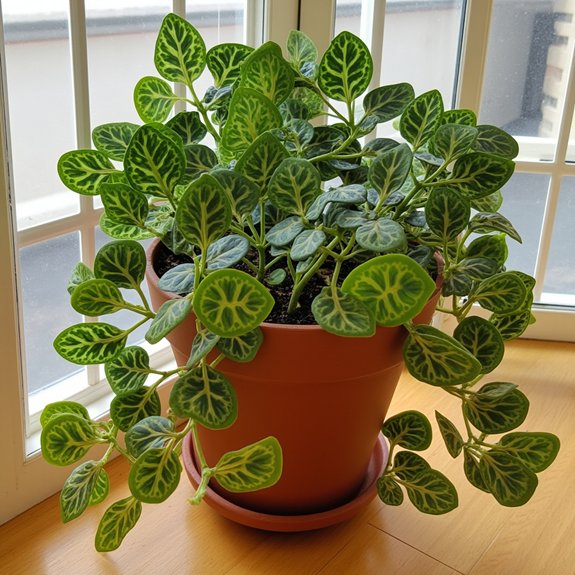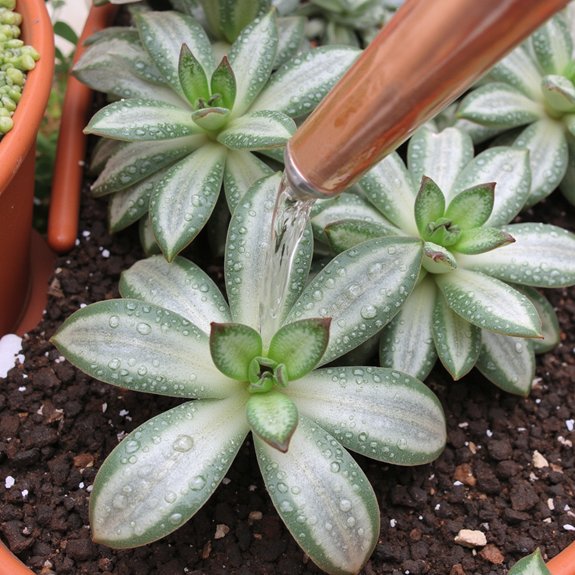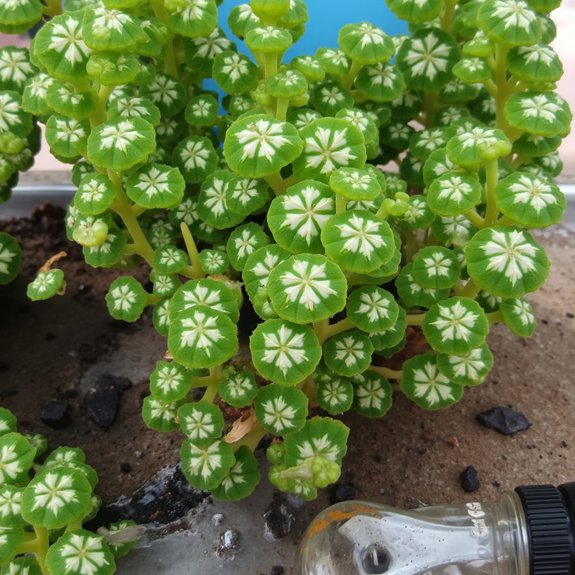Like a living piece of art cascading from its pot, the String of Turtles captivates plant enthusiasts with its intricate turtle shell patterns and trailing vines. This Peperomia prostrata demands specific care that goes beyond typical houseplant maintenance. Most gardeners don’t realize they’re making three critical mistakes that prevent those coveted turtle markings from developing properly, causing their plant to lose its signature beauty within just weeks of bringing it home.
Contents
- 1 Understanding Peperomia Prostrata: The Turtle Shell Plant
- 2 Creating the Perfect Growing Environment
- 3 Watering Techniques and Soil Requirements
- 4 Temperature and Humidity Management
- 5 Fertilizing for Healthy Growth and Vibrant Markings
- 6 Maintenance, Pruning, and Propagation Methods
- 7 Troubleshooting Common Issues and Pest Control
Understanding Peperomia Prostrata: The Turtle Shell Plant

Charm radiates from every tiny leaf of Peperomia prostrata, better known as the String of Turtles plant. This tropical beauty showcases round, waxy leaves that perfectly mimic turtle shell characteristics with their distinctive patterns and markings. Native to the warm regions of Central and South America, these cascading vines reflect their tropical origins through their love for humidity and warmth. The plant’s thin, fleshy strings can stretch up to 12 inches, with the largest leaves positioned at the top. Small reddish-brown flower stalks produce tiny cream blooms throughout the year, adding subtle elegance to this slow-growing houseplant.
Creating the Perfect Growing Environment
Since String of Turtles plants originate from tropical rainforests, they’ll thrive when you replicate those warm, filtered-light conditions indoors. Position them near south or east-facing windows for bright, indirect sunlight. Direct sun burns their delicate leaves, so avoid harsh exposure.
Light requirements include at least six hours of filtered brightness daily. Grow lights work excellently for darker spaces. Keep temperatures between 68°F-75°F, avoiding cold drafts that shock these tropical beauties.
Humidity levels should hover around 50%, though they’ll tolerate 40% just fine. Use humidity trays or group plants together to boost moisture naturally.
Watering Techniques and Soil Requirements

While String of Turtles plants store water in their semi-succulent leaves, they’re surprisingly picky about their watering schedule. Check the top two inches of soil before watering, and only proceed when completely dry. Water from the base to maintain proper moisture balance without soaking the delicate foliage.
For soil, create a rich, well-draining mix using two parts coco peat, one part compost, and one part perlite. This combination provides excellent drainage solutions while retaining enough nutrients. Avoid commercial succulent mixes, they’re too lean for these tropical beauties. Aim for neutral to slightly acidic pH levels.
Temperature and Humidity Management
Temperature stability becomes essential for String of Turtles plants, as these tropical natives thrive in consistent warmth between 68°F and 75°F indoors. Cold drafts can shock these delicate plants, so keep them away from windows, doors, and air conditioning vents.
Humidity levels around 50% create ideal growing conditions, though they’ll tolerate anything above 40%. Temperature fluctuations stress the plant and can cause leaf drop or stunted growth. If outdoor temperatures dip below 50°F, bring plants inside immediately or move them to a heated greenhouse for protection.
Fertilizing for Healthy Growth and Vibrant Markings

During spring and summer growing seasons, String of Turtles plants benefit from regular feeding with water-soluble liquid fertilizer or specialized succulent food. These fertilizer types provide essential nutrients that maintain healthy leaf development and enhance those distinctive turtle-shell markings everyone loves.
A proper feeding schedule involves monthly applications throughout the active growing period. Skip fertilizing completely during fall and winter when growth naturally slows down. Over-fertilization can actually cause leaf drop, so less is definitely more with these plants.
Monitor your plant’s response carefully, adjusting frequency if you notice any stress signs or excessive growth.
Maintenance, Pruning, and Propagation Methods
String of Turtles plants require minimal maintenance once you’ve established proper growing conditions, making them perfect for busy plant parents. Regular pruning techniques involve using clean, sterilized secateurs to trim back unruly growth, which actually promotes healthier new development. Never remove more than one-third of the plant’s growth at once.
Propagation methods are surprisingly simple. Broken stems become opportunities—place cuttings in water or soil during spring for best results. Those damaged vines you just pruned? They’re perfect propagation material. This cascading beauty practically multiplies itself with minimal effort from you.
Troubleshooting Common Issues and Pest Control
While String of Turtles plants are generally resilient, they can fall victim to several common issues that’ll test your plant parenting skills. Root rot emerges as the most serious threat, typically caused by overwatering or poor drainage. You’ll notice mushy, blackened roots and yellowing leaves. Remove affected roots immediately, repot in fresh soil, and adjust your watering schedule.
For pest identification, watch for spider mites, mealybugs, and whiteflies. These tiny invaders appear as webbing, white cottony spots, or small flying insects respectively. Combat them with neem oil or insecticidal soap, cleaning leaves thoroughly to eliminate eggs and larvae.
